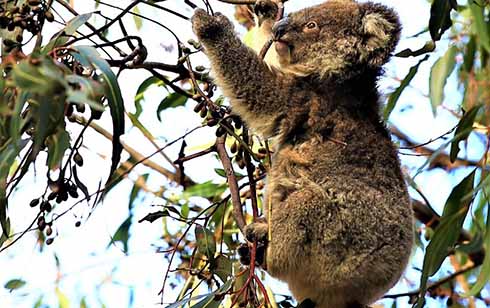 I saw a koala in the wild for the first time last year, on a visit to Kangaroo Island. It was a thrilling moment, captured in frames by my fast shutter-speed eyes and tucked like treasure into my memory.
I saw a koala in the wild for the first time last year, on a visit to Kangaroo Island. It was a thrilling moment, captured in frames by my fast shutter-speed eyes and tucked like treasure into my memory.
The creature had climbed down from one towering eucalypt and was ambling over to another; catching sight of us humans, it raced – in that awkward, shambling way – to the opposite trunk, wrapped its squat little arms around it and pulled itself up into the safety of the canopy.
It was a soul-enriching experience in a place I’d only seen, until now, in my imagination, a ‘zoo without fences’ as my guide Kelly Gledhill described this paradise on the drive westwards from the airport.
Curling along that Mallee-rimmed ribbon of road – now immortalised as an ashen, post-apocalyptic moonscape – we saw the first of several echidnas, scurrying furtively across the road and disappearing into the tangle of vegetation on the other side. We halted for Cape Barren Geese ambling across our path; so carefully protected are these ground-dwelling birds, drivers must take care not to hit one or they will be served with a hefty fine.
Australia’s Galapagos
‘This is Australia’s Galapagos,’ Gledhill said as we glided through its gently undulating interior. ‘We’ve got kangaroos, ring-tailed possums, echidnas, reptiles and birds – and the smallest wallabies in Australia.’
And koalas, of course. But these marsupials aren’t native to Kangaroo Island: a colony of 18 koalas was introduced from the mainland in 1923; by 2019, their descendants numbered an impressive 50,000 (all free of the chlamydia that besets mainland populations). So fruitful was their translocation, Gledhill says, population control measures were introduced and some of the colony were sent back to continental Australia.
Turning off the main road, we burrowed now into a verdant tunnel; at the end of it stood one of Australia’s flagship properties, Southern Ocean Lodge. Entering its vaulted, glass encased great room, I turned my head from the rolling waves on one side to the rolling bush on the other. Each was an ocean unto itself: the Southern Ocean stretching all the way to Antarctica, the coastal scrub and Mallee woodland rippling largely undisturbed to the island’s northern edge.
Winter in paradise
Rainbows sprung from the ocean intermittently, like some specially-planned light show; some of them arced all the way from one pot of gold to the other. It was winter in this paradise, and moisture had electrified the landscape and conspired with the sun to stripe the sky with pastel hues.
But danger was lurking. There’d been no rain from December to April; it had been so hot, Gledhill said, the earth had started to crack. We didn’t know it then, but winter’s rain wouldn’t be enough to slake the island’s thirst. When the fires tore across it in early January, the bush was tinder-dry and little was spared.
Back home in Sydney, I watched in shock as footage emerged of the inferno. Flames devoured the woodlands close to where I’d spotted that first koala and, later, a joey that had recently left the care of his mum and was dangling precipitously on the end of a branch as he reached for fistfuls of gum leaves. ‘Don’t fall, baby!’ I’d cried, and now falling seemed like not much of a calamity at all.
Fire comes again
It wasn’t the first time the island had been engulfed: in 2007 lightning ignited a fire which burned out 80 per cent of Flinders National Park. The flames came within 2km of the lodge’s construction site; they were halted by a firebreak. A bunker was added to the design so that staff and guests would have a place to shelter should fire ever threaten the island again.
And so it came to pass on 3 January, when the fire roared towards the lodge and swallowed it whole. Just like that, this glorious, sweeping edifice was reduced to a mound of scorched rubble. When the fire had extinguished itself and the embers had cooled, a phoenix of sorts could be seen rising from the ashes in the shell of the great room: an oversized kangaroo, sculpted from metal. Its survival is a taunting reminder of the crisped bodies of once-living creatures lying felled across this island – including the estimated 25,000 koalas thought to have perished in the conflagration.
Or it’s a sign of hope, a talisman foretelling a time when winter will return to quench this scorched earth, shoots of green will slowly colour the embers, and rainbows will spring optimistically from the ocean, giving hope to those left behind.
This article first appeared in Eureka Street.
Image: Catherine Marshall